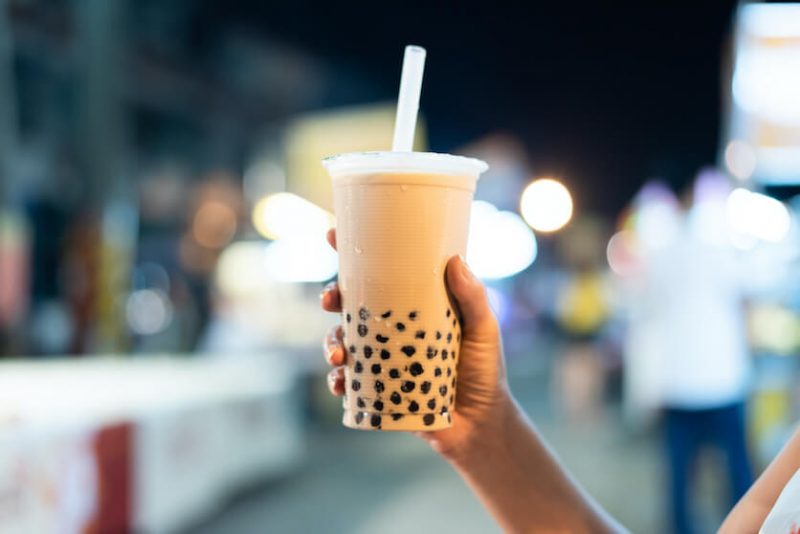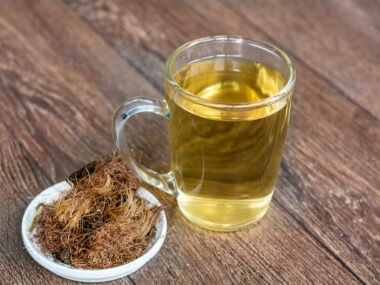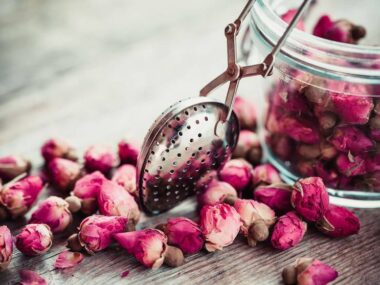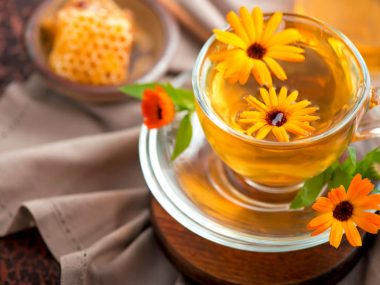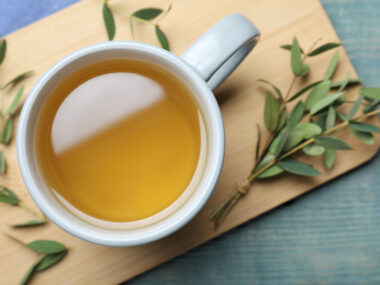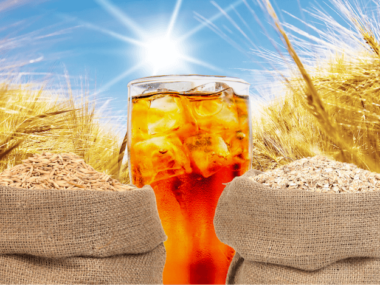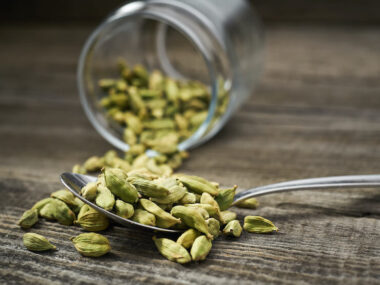It’s not the milk that sets this Okinawa milk tea apart from other milk teas. You’ll be surprised to find out the secret ingredient is growing right in the garden or backyards of many on the Japanese Island!
Table of Contents
What Is Okinawa Milk Tea?
Okinawa milk tea is a Japanese bubble tea that has begun to slowly make its way into western tea shops. Here in the U.S., you’ll find versions of this tea served in Starbucks and a few select tea shops. So, what makes this bubble tea so unique? It’s one single ingredient that makes it truly an Okinawan delight!
As with any milk tea, there are three basic ingredients that go into making the tea. It starts with a dairy base (a type of milk; cow, soy, oat, almond, etc.) Black tapioca pearls are the next ingredient. The third ingredient is ice.
Those of us here in the U.S. are not necessarily familiar with tapioca pearls. These small, squeaky, little black balls of chewy goodness are made from the root paste of the cassava plant. Other ingredients include sweet potatoes, brown sugar, and coloring.
What sets various milk teas apart are the additives. An additive may be tea (black, green, yellow, oolong, white,) fruit, jellies, herbs, or brown sugar. These additives may go into the milk base itself or be added as a topping. The sky’s the limit when it comes to creating different concoctions of bubble/milk teas.
Today you can easily enjoy:
What Is Okinawa Milk Tea Made Of?
Most assume an Okinawa milk tea is made with special milk only found on the namesake Japanese island. However, this isn’t the case. Ironically, there are numerous online sites that claim the tea gets its name because of having Okinawan cow’s milk.
So, let’s go back to our three basic milk tea ingredients, which all go into the Okinawa milk tea.
- Dairy milk (cow’s, soy, oat, almond, coconut, rice, etc.)
- Black tapioca pearls
- Ice
Black tea (Assam) is yet another ingredient added to this milk tea. And now, we give you the special ingredient that makes this milk an Okinawa milk tea. It is kokuto!
What is Kokuto?
Kokuto is a brown sugar produced in Okinawa. This brown sugar is nothing like typical brown sugar as we know it. To better understand this unique sweetener, let’s look at how it’s made.
Kokuto is grown as cane sugar in Okinawa, where it is harvested and taken to small refinery factories. Unlike the brown sugar that we know, kokuto does not undergo the centrifugal extraction of sugar molasses.
Most brown sugars that we use are hyper-refined to remove the molasses. A small portion of that removed molasses is then added back into the sugar. This produces a more sugary, sweet brown sugar. However, with kokuto, there is no refinement or removal of the molasses.
The molasses is where numerous nutritional benefits reside. Kokuto brown sugar is packed with those benefits because of the presence of molasses. The dark molasses is why kokuto got the nickname “black sugar.”
Kokuto is processed into cubes, rocks, cakes, or powder forms. Any form of this brown sugar can be used in cooking, to make Okinawa milk tea, or to eat as a sweet treat.
When adding kokuto to Okinawa milk tea, it is added to the Assam tea when steeping. The hot tea melts the kokuto, making the Assam tea very sweet. Depending on the preparation method used to make this milk tea, some tea shops will use the sweetened Assam black tea to paint stripes inside of a clear plastic cup before the milk is added. This gives the finished drink a tiger-stripe effect because of the dark stripes of black tea against the white milk background.
What Is The Difference Between Hokkaido and Okinawa Milk Tea?
Hokkaido is a Japanese island situated north of the mainland, whereas Okinawa is located south of the mainland. The two have their specialty drinks, and some people get them mixed up with one another. These drinks are different, and it’s the differences that we will look at.
Not to confuse things further, you may find that Okinawa milk tea is also called “Okinawa pearl tea” or “Okinawa brown sugar milk tea.”
Hokkaido Vs Okinawa Milk Tea
Hokkaido | Okinawa Milk Tea |
Dairy base: local cow’s milk | Dairy base: milk |
Tea additive: Assam black tea | Tea additive: Assam black tea |
Sweetener additive: regular brown sugar, honey, caramel | Sweetener additive: kukuto |
What Is The Taste Of Okinawa Milk Tea?
The Journal of the Japanese Society for Food Science and Technology published an article on how kukuto (an ingredient in Okinawa milk tea) tasted. The study states that according to sensory testing, kukuto exhibits a “strong astringent/bitter-like” flavor.
When marrying kukuto’s sweet yet bitter flavor component to the creamy milk and subtle sweetness of the tapioca pearls, all of the flavors present within this milk tea seem to pair perfectly.
The resulting flavor profile of this milk tea is a smooth and creamy experience highlighted with hints of earthy buttery caramel.
Is Okinawa Milk Tea Healthy?
Unfortunately, milk/bubble teas are chocked full of carbohydrates because of the sugar. Although kukuto is an unrefined brown sugar with a better nutritional profile than regular brown sugar, it still contributes to the total carbs in one of these drinks.
Milk (bubble) teas universally contain an excessive amount of sugar. One of these drinks may have as much sugar as chocolate frosted cake! As with any sweet treat (including milk tea), moderation is a must. Otherwise, you may find that your bathroom scale may not be such a good friend anymore.
Most milk teas offer little nutritional benefit. Many tea shops are opting to use powder mixes in place of fresh ingredients. Those powder mixes may contain even more calories and sugar and, shockingly, very little dairy except for what’s labeled as “dairy creamer.”
Ordering An Okinawa Milk Tea
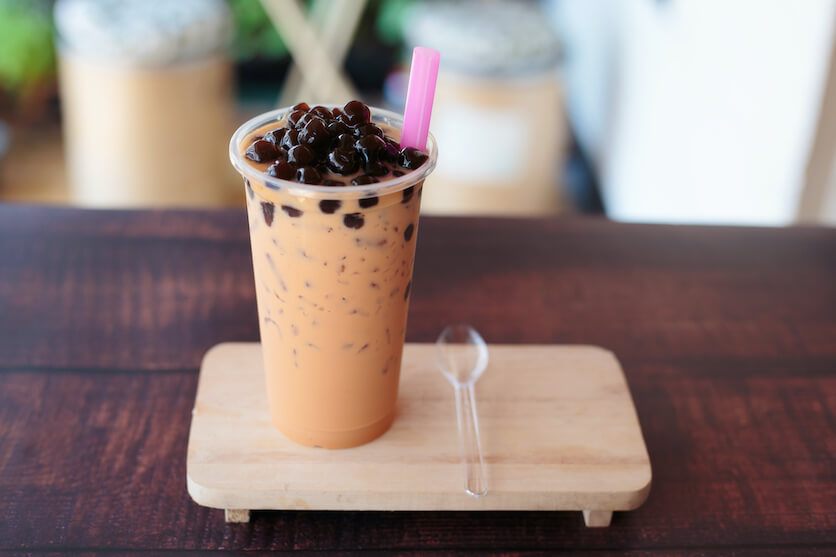
So, when in Okinawa, do as the locals do. Splurge occasionally and enjoy a bubble (milk) tea. At the top of most menus is the black sugar (kukuto) milk tea. Different tea shops sell them under names such as “The Black Sugar Bomb” or “Okinawa Brown Sugar Boba.”
Just a word of caution, most bubble tea shops use bulk-size milk tea mixes, which are prepared ahead of time. As a customer orders their desired beverage, the dairy base (already made from a mix) is poured into a cup, and the extras such as black tea and kukuto are added along with ice. The black tapioca pearls are rarely fresh as well and come prepackaged.
To start an order, you must decide how much ice and sweetness you would like in your milk tea.
Sugar Grade/Level — the amount of sweetness you’d like)
- 100% = as sweet as it can get
- 70% = very sweet
- 50% = sweet
- 30% = subtle sweetness, not overpowering
- 0% = no sugar
Ice
- Regular = full cup
- Less = ¾ full
- Light = ½ full
- None = no ice
So, your milk tea barista has your desired ice and sweetness. The next step is to take a spoon with the black tea and kukuto mix and paint stripes on the inside of the clear plastic cup. Next, the black tapioca pearls and more black tea and kukoto are added, filling the cup about ¼ full.
Ice is next, then the milk (or powder mix base.) The top of the cup is sealed with special plastic. You are instructed to tip the cup several times to mix the ingredients. A wide straw is inserted into the plastic in which you can sip the tea while getting bites of tapioca pearls.
Can Okinawa Milk Tea Be Enjoyed Daily?
This milk tea, like any other milk tea, should be an occasional treat to be enjoyed in moderation. This is not an ideal beverage to consume daily because of the number of calories, carbs, and sugars.
In a research article entitled “Calories and sugars in boba milk tea: implications for obesity risk in Asian Pacific Islanders,” milk teas (boba/bubble) were found to be high in calories, carbohydrates, sugars, and fat. An average 12 oz. milk tea has 38 g of carbs!
Does Okinawa Milk Tea Have Caffeine?
The only time any milk tea contains caffeine is if a true tea (black, green, oolong, yellow, white) is added. Okinawa milk tea contains Assam black tea, and depending on how much black tea goes into preparing this milk tea. It may have up to 20-30 mg of caffeine.
How to Make Okinawa Milk Tea
For a traditional, make-at-home Okinawa milk tea, you will need to do a bit of planning ahead to get the ingredients you’ll need.
Traditional Okinawa Milk Tea Recipe
Ingredients
- 1 medium kukuto rock (or half a square)
- 1 ½ teaspoons of loose-leaf Assam black tea
- 1 ½ cups of milk
- 1 cup of water
- ½ cup of black tapioca pearls (prepackaged)
Directions
(Prepare the black tea)
- Bring 1 cup of water to a boil
- Remove from the heat.
- Add the loose-leaf tea and kukuto to the hot water.
- Cover and allow to steep for 5 minutes.
- Remove the cover.
- Strain the tea into a glass and set it aside to cool for about 10-15 minutes.
- Discard the spent tea leaves.
(Prepare the tapioca pearls)
- Place the black tapioca pearls into a strainer.
- Run the pearls under cold water to rinse the starchy film off.
- Strain thoroughly.
(Prepare the milk tea drink)
- Using a spoon or knife, dip it into the tea mixture and paint vertical lines inside of a clear glass.
- Place the spoon/knife into the sink.
- Pour the tapioca pearl into the button of the glass.
- Pour the tea/kukuto mixture into the glass (layered on the tapioca pearls.)
- Fill the glass halfway with ice (layered on the tapioca/tea.)
- Gently pour the milk into the glass.
- Insert a wide straw, and enjoy!
A Japanese Delight!
Now you know what makes Okinawa milk tea different from other milk teas. If you haven’t tried it, it’s well worth a treat. Who knows, you may find yourself in that part of the world someday with the opportunity to enjoy the real deal!
